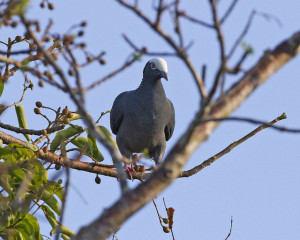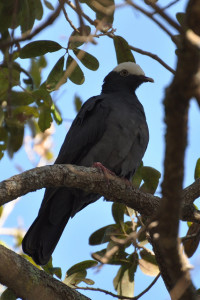Content for this page researched and created by Josh Gump

Although actual numerical data have not been recorded, it is widely believed that the flight speed of the White-crowned pigeon (Patagioenas leucocephala) is faster than some motorboats. The species exhibits this great speed in their daily thirty mile flight patterns between nesting and foraging habitats (All About Birds). The White-crowned pigeon is considered endemic to the Caribbean region of the world. Within this region, it is widely distributed throughout Southern Florida and the West Indies, but is considered a permanent resident in Cuba (Kiwan, Kirkconnell, and Flieg). Despite having a relatively widespread range, actual population and reproductive numbers are largely dependent upon food supply (The Birds of North America Online).
It is worth noting that the White-crowned pigeon is closely related and often compared to the Rock Pigeon (Columba livia). Despite their relative similarities, the White-crowned pigeon is distinct due to its white crown, smaller build, as well as its sloping forehead and longer tail (NatureServe Explorer). The typical adult pigeon is thirteen to fourteen inches long and weighs seven to nine ounces. Most notably, male adults will exhibit the defining white crown atop their head which extends downward to their eye level (Garrido and Kirkconnell). Additionally, a sequence of iridescent green feathers can be observed along the backside of an adult pigeon’s slate gray (almost black) neck (All About Birds). Rather than having a white cap, juveniles have a brownish-white forehead and pale gray feathers.

The White-crowned pigeon adheres to three different movement types (Wiley). Making use of swift, direct flight patterns and strong, rapid wing beats, they will travel from nesting areas to feeding areas, and back (The Website of Everything). They will also travel from coastal to interior island regions based on the season. Finally, they will migrate from island to island based on the availability of food supplies.
Overall, they have a diet based largely on the fruits from the poisonwood, strangler fig, short-leaf fig, and blolly trees (Wildsceen Arkive). However, coastal areas within the Caribbean usually provide an abundance of small (10-25 mm) land snails. It has been documented that under instances of food shortages, adult pigeons will feed land snails to their juveniles (Seaman).
The typical nesting season for the White-crowned pigeon begins in late April and extends through August (Garrido and Kirkconnell). Overall, the White-crowned pigeon has several preferences regarding its choice in nesting and breeding environments. Their preferred nesting environment is an isolated, offshore mangrove inlet (ICUN Red List). Such an environment will allow for successful, undisturbed breeding. Altogether, breeding occurs throughout the Caribbean. Breeding is most common in the Bahamas, Cuba, Jamaica, and Antigua (ICUN Red List).

Nests can also be found in coastal and inner-island forests that contain hardwood, fruit-bearing trees. The White-crowned pigeon tends to build a very basic platform nest, loosely composed of twigs sitting high in mangroves (Wells). Pigeons have the potential to nest up to four times per year. Male pigeons will choose a nesting site or larger territory and attempt to attract a female to the area (The Birds of North America Online). During the nest building process, males will project a deep “cru-curu-cr-ob” sound (Wiley and Wiley).
While mating, the male and female will share a very strong bond (Planet of Birds). The typical clutch size is 1-3 eggs (All About Birds). In total, the incubation process takes 13-14 days. During this time, both the male and female will incubate the eggs. The male typically tends to nest during the day, while the females incubate at night (The Birds of North America Online). The juvenile pigeons will flee the nest 21-23 days after hatching (Planet of Birds). Before the juveniles fledge they will feast on a diet almost entirely composed of crop milk. The milk is simply just partially digested food, regurgitated by the adult into the mouths of the nestlings. It contains high quantities of proteins and lipids to promote rapid growth of the nestlings (Bancroft and Bowman).
Pigeon nesting can occur in colonies in which hundreds of nests can be found in one woodland area (Garrido and Kirkconnell). The nests will typically be located in safe sites near abundant food sources (Strong and Johnson). In areas where colonized nesting does not occur, aggressive behavior among male pigeons is common during breeding season (Wiley and Wiley). If a male is not present at his nest and an intruder enters the territory this can result in one of two actions. Most commonly, the invading pigeon will be chased out of the area by the territorial pigeon. However, if this does not work, male pigeons will resort to the use of frontal aerial attacks, until the intruder flees (The Birds of North America Online).

One nesting location that has become increasingly problematic is Florida. A decline in the pigeon population throughout Florida can be attributed to the heightened level of predator presence, as well as the deforestation of ideal foraging ecosystems. Pigeons will typically arrive in Florida during early to middle May, and they will migrate to the Southern Caribbean islands during September (Greene). Pigeon breeding within Florida is positively correlated with summer rains and overall fruit production especially the fruit of the Poisonwood (Metopium toxiferum) tree (Bancroft, Bowman, and Sawicki). Specifically, within the Florida Bay, nesting occurs away from the mainland due to predator presence (Strong, Sawicki, and Bancroft). Typical predators in this region are the Red-winged blackbirds, Laughing gulls, American crows, and in some areas, the Virginia opossum and bobcat. However, the range of the nesting area is most commonly restricted due to the presence of raccoons. Raccoons appear to be the most efficient nest predator. Thus, in an effort to reduce the raccoon effect in Florida, nests are typically built 20 feet above the ground in trees or bushes (Wells).

The White-crowned pigeon plays an important role regarding seed dispersal and plant diversity, especially within the Florida ecosystem (NatureServe Explorer). In spite of this, little is being done to conserve the existing population and encourage it to grow. In an observational study, Arendt, Vargas-Mora, and Wiley (1979) identified hunting for sport as being a major contributor to the population decline within the Dominican Republic at the time. They also attributed the population decline to a large amount of habitat destruction, which was initiated to expand upon city limits. Currently, within the United States and Bahamas, limitations have been placed on the number of pigeons that can be hunted (Wildscreen Arkive). Despite this conservation effect, as of 2008, the White-crowned pigeon is classified as Near Threatened (IUCN Red List). The major threats to the population include illegal hunting, deforestation, as well as the removal of the Poisonwood from Florida ecosystems. The removal of the Poisonwood is especially problematic. The dull, yellow fruit found on the tree is an especially important source of food for the pigeons during breeding season. Unfortunately for the pigeons, the Poisonwood is removed due to its effect on humans. When a human comes in contact with the sap of the Poisonwood, it can cause severe dermatitis.
General References:
Garrido, O. H. and A. Kirkconnell. Field Guide to the Birds of Cuba. Ithaca. Cornell University Press. 2000. Print.
Kirwan, G., A. Kirkconnell, and M. Flieg. A Birdwatchers Guide to Cuba, Jamaica, Hispaniola, Puerto Rico, and the Caymans. Cley, United Kingdom. Prion Ltd. 2010. Print.
Patagioenas leucocephala. NatureServe Explorer. 2015. Web. 25 September 2015.
Patagioenas leucocephala. The IUCN Red List of Threatened Species. 2012. Web. 25 September 2015.
White-crowned Pigeon. All About Birds. 2015. Web. 25 September 2015.
White-crowned Pigeon. The Birds of North America Online. 2015. Web. 25 September 2015.
White-crowned pigeon. The Website of Everything. 2010. Web. 25 September 2015.
White-crowned Pigeon Patagioenas leucocephala. Bird Life International. 2015. Web. 25 September 2015.
White-crowned Pigeon (Patagioenas leucocephala). Planet of Birds. 2011. Web. 25 September 2015.
White-crowned pigeon (Patagioenas leucocephala). Wildscreen Arkive. 2015. Web. 25 September 2015.
Scientific References:
Arendt, Wayne J., Tomas A. Vargas-Mora, and James W. Wiley. “White-Crowned Pigeon: Status Rangewide and in the Dominican Republic.” Proc. Ann. Conf. S.E. Assoc. Fish & Wildl. Agencies (1979): 111-122. Google Scholar. Web. 24 September 2015.
Bancroft, Tomas G., and Reed Bowman. “Temporal Patterns in Diet o Nestling White- Crowned Pigeons: Implications or Conservation o Frugivorous Columbids.” The Auk (1994): 844-852. JSTOR. Web. 9 September 2015.
Bancroft, Tomas G., Reed Bowman, and Richard J. Sawicki. “Rainfall, Fruiting Phenology, and the Nesting Season of White-Crowned Pigeons in the Upper Florida Keys.” The Auk (2000): 416-426. Google Scholar. Web. 9 September 2015.
Greene, Earle R. “Notes on Certain Birds o the Lower Florida Keys.” The Auk (1944): 302- 304. JSTOR. Web. 24 September 2015.
Seaman, G. A. “Land Snails as Food of White-Crowned Pigeon.” The Auk (1959): 232. JSTOR. Web. 24 September 2015.
Strong, Allan M., and Matthew D. Johnson. “Exploitation of a Seasonal Resource by Nonbreeding Plain and White-Crowned Pigeons: Implications for Conservation of Tropical Dry Forests.” The Wilson Bulletin (2001): 73-77. Google Scholar. Web. 9 September 2015.
Strong, Allan M., Richard J. Sawicki, and G.T. Bancroft. “Effects of Predator Presence on the Nesting Distribution of White-Crowned Pigeons in Florida Bay.” The Wilson Bulletin (1991): 415-425. JSTOR. Web. 9 September 2015.
Wells, Jeffrey V. “White-crowned Pigeon (Patagioenas leucocephala).” Birder’s Conservation Handbook (2007): 229-231. JSTOR. Web. 9 September 2015.
Wiley, James W., and Beth N. Wiley. “The Biology of the White-Crowned Pigeon.” The Wildlife Society (1979): 3-54. JSTOR. Web. 9 September 2015.
Wiley, James W. “The White-Crowned Pigeon in Puerto Rico: Status, Distribution, and Movements.” The Journal of Wildlife Management (1979): 402-413. JSTOR. Web. 9 September 2015.
Images:
Flickr. Yahoo. 2012. Web. 25 September 2015. <http://flickr.com/photos> (Use via Creative Commons)
- White-crowned pigeon on oak branch (B. Trentler)
- White-crowned pigeon upright on tree branch (L. Kee)
- White-crowned pigeon frontal shot (L. Kee)
- White-crowned pigeon side shot (L. Kee)
- White-crowned pigeon leaning on tree branch (L. Kee)